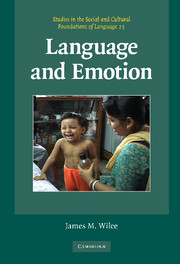Book contents
- Frontmatter
- Contents
- List of figures
- List of transcripts
- Acknowledgements
- Introduction
- Part I Theory
- Part II Language, power, and honor
- Part III Identification and identity
- 7 Language as emotional object: feeling, language, and processes of identification
- 8 Language, affect, gender, and sexuality
- Part IV Histories of language and emotion
- Notes
- Glossary
- References
- Index
- STUDIES IN THE SOCIAL AND CULTURAL FOUNDATIONS OF LANGUAGE
8 - Language, affect, gender, and sexuality
Published online by Cambridge University Press: 05 June 2012
- Frontmatter
- Contents
- List of figures
- List of transcripts
- Acknowledgements
- Introduction
- Part I Theory
- Part II Language, power, and honor
- Part III Identification and identity
- 7 Language as emotional object: feeling, language, and processes of identification
- 8 Language, affect, gender, and sexuality
- Part IV Histories of language and emotion
- Notes
- Glossary
- References
- Index
- STUDIES IN THE SOCIAL AND CULTURAL FOUNDATIONS OF LANGUAGE
Summary
Introduction
The triple relationship of language, emotion, and gender is a minefield. Representations of that relationship, no doubt including my own, scarcely avoid reflecting biases old and new. Indeed the very mention of emotion, for some, evokes gender. This chapter, however, seeks to shed new light on this intersection rather than simply recirculate old ideas. In doing so, I continue to draw on models arising out of research on language ideologies. Studying language ideologies can bridge linguistic and social theory, providing “a mediating link between social forms and forms of talk” (Woolard 1998: 3). Thus, for example, they link power-based, always partial visions of gender relations, with equally power-related visions of language use and practice. These visions are crucial to processes of social reproduction insofar as they undergird socialization (or enculturation) and rituals central to the social order. The interplay of ideology and practice involves relative degrees of awareness; various forms of (potentially distorting) awareness can provide powerful insights into “language as a social tool” and “cultural resource” (Duranti 1997: 1, 2). Duranti's description points, among other things, to the ideological uses of language, i.e., cultural models of language. (Concepts of) language(s) are tools for doing important ideological work.
We can also theorize language ideologies in terms of orders of indexicality. From this perspective, language ideologies are second-order indexes, i.e., social acts of pointing to (or imagining, constituting) lower-order indexes. The latter include, e.g., popularly perceived co-occurrence patterns involving ‘gender identity’ – the reality of shifting moments of identification being perhaps less stable than ‘identity’ would indicate. But higher-order indexes – here, language ideologies – influence lower-order instances, by increasing or otherwise shaping consciousness.
- Type
- Chapter
- Information
- Language and Emotion , pp. 119 - 134Publisher: Cambridge University PressPrint publication year: 2009



